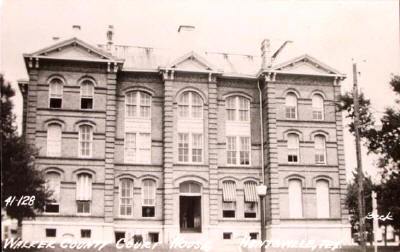|
Texas
| Architecture
| Courthouses
Dignity, Decorum
and Justice
Mark Texas' Courthouse Histories,
Except for the Fights, Arsons, Thefts, etc
by Bill Morgan
Page 5
‹ Page
4
What's in
a Name?
|
‹
Page
4
If
the clerks who filled in indictments had the spelling skills of early
Texas Legislatures, all those indictments would have been thrown out
on technicalities. Remember that red-letter day of August 21, 1876
when Texas named 56 new counties? It had a downside - neither the
Legislature nor the residents of the new counties necessarily knew
or had even heard of the people for whom the counties were named.
A second factor figures in the misspelling bee: several names were
taken from military records, and we know that those things have been
getting fouled up since long before the Pharaoh's lead charioteer
figured he could outrun the Red Sea. So it's probably more surprising
that more names weren't mangled in the christenings. Here are some
that were: Motley (one
"t") County is named for Battle
of San Jacinto casualty Dr. Junius William Mottley (two "t's");
Randall
(two "l's") is named for Horace Randal (one "l"), a Texas and Confederate
general killed at Jenkins Ferry. Three counties are named or misnamed
for Alamo defenders - Dickens
County is likely named for a man whose name is on the records
as James R. Demkins, James R. Dimpkins, and J. Dickens; Lynn
County honors an Alamo
defender whose name was recorded as both Linn and Lynn; and Kimble
County's namesake was listed as both George C. Kimball and George
C. Kimble. Phillip Dimmitt and James Collinsworth are united in two
ways in Texas history - both took part in capturing Goliad
and both had counties misnamed for them (Dimmit,
one "t" and Collingsworth,
a "g" added); Uvalde
gets a double whammy. Both the county and its seat were at least consistently
misspelled, with the "g" changed to "v" in honoring Captain Juan de
Ugalde, an Eighteenth Century Spanish soldier, politician and Indian
fighter; And perhaps the strangest misspelling of all - Hallettsville,
the seat of Lavaca County,
was built on land donated by the widow of John Hallet (one "t"). Margaret
Hallet lived on for several decades in the town that almost bore her
name. There's no record that she ever called the mistake to anyone's
attention, much less that it bothered her. Look a little closer and
a misspelled name doesn't seem to be such a big deal. The real downside
to having a Texas county named for you is the price you paid for the
honor. I figured 207 of the 254 counties are named for people, all
the way from A (Kenneth Lewis Anderson, vice president of the Republic
of Texas) to Z (Lorenzo de Zavala, a political and military leader
in the Texas Revolution). And about two-thirds of them died violent
deaths. One unforgettable example: Antonio Zapata, a rancher and politician
along what would become the Texas-Mexican border, became a Federalist
colonel in the Mexican Civil War. Centralists captured and killed
him, then severed his head and paraded it around the plaza of his
hometown of Guerrero,
just across the Rio Grande from the future site of the county and
town named for him.
Still, getting a county named for you was occasionally easier than
keeping it. If the honoree fell into political disfavor, the Legislature
renamed the county. Congressmen hailed as heroes for helping Texas
become the 28th state on December 19, 1845 became persona non grata
little more than a decade later when they showed up on the Yankee
side of the Civil War.
Cass County was named
for Michigan Senator Lewis Cass, who championed Texas' bid for statehood.
When he became the enemy the county changed its name to Davis in honor
of the Confederate president. Then the Reconstruction government restored
the Cass name. Jefferson Davis came out ahead, too, getting both a
county and county seat named for him in Big
Bend country. |
 |
The 1888 (former)
Walker County Courthouse, burned.
Photo
courtesy texasoldphotos.com |
Walker
County had it much simpler. It was originally named for Robert
J. Walker, a Mississippi congressman who introduced legislation to
annex Texas into the Union. Then the Civil War came along and Walker
became an Unionist. The Legislature easily solved that problem: it
decreed that from now on Walker
County be named for Texas
Ranger Captain Samuel H. Walker. Let's see 'em pull that trick
with Red River
or Val Verde
counties.
My favorite story about county seat names doesn't involve misspelling,
political patronage, pioneer families, none of the usual standards.
It happened this way out close to the geographic center of the
Panhandle: A Fort Worth & Denver steam engine stopped at a small
town to take on water. The engineer hailed a passing cowboy and asked
the name of the town. The cowboy said that was the community's most
pertinent question, because city fathers couldn't agree on one. "Why
not name it for me?" the engineer asked. Why not? agreed the cowboy,
who passed the engineer's name and suggestion along to the decision-makers.
The train engineer never lived in that little Panhandle town, but
he made arrangements to be buried there. Railroad engineer Claude
Ayers' grave is in the cemetery at Claude,
Texas, the seat of Armstrong
County and the town that took his name.
Page
6
The Artists in Brick, Stone and Mortar
When it came to names, Texas attracted some of the biggest among the
country's Nineteenth Century architects, the men whose work inspired
that less-than-modest label "The Golden Age of Texas Courthouse Architecture."
Designers spread out across Texas quicker than the railroads in the
last quarter of that century. Courthouses were evolving into the counties'
socio-economic bell cow and every politician and civic leader wanted
a defining landmark. Page
6 › |
©
Bill Morgan
June
9, 2005
More
Texas Courthouses |
Recommended
Book
Old Friends: Great Texas Courthouses |
|
|
|
